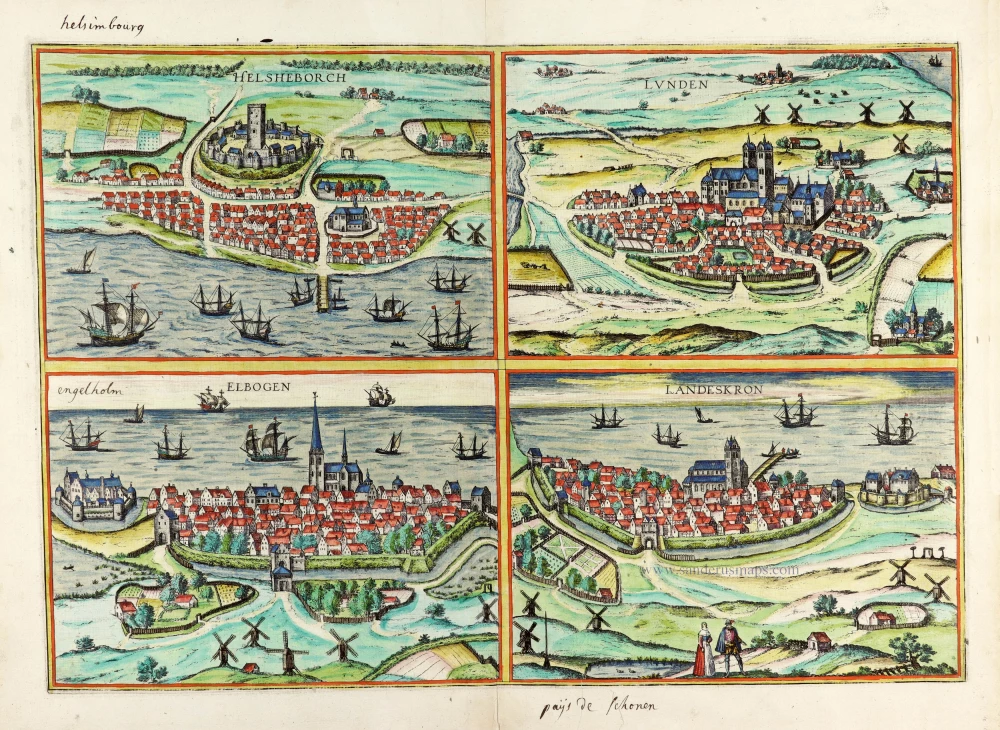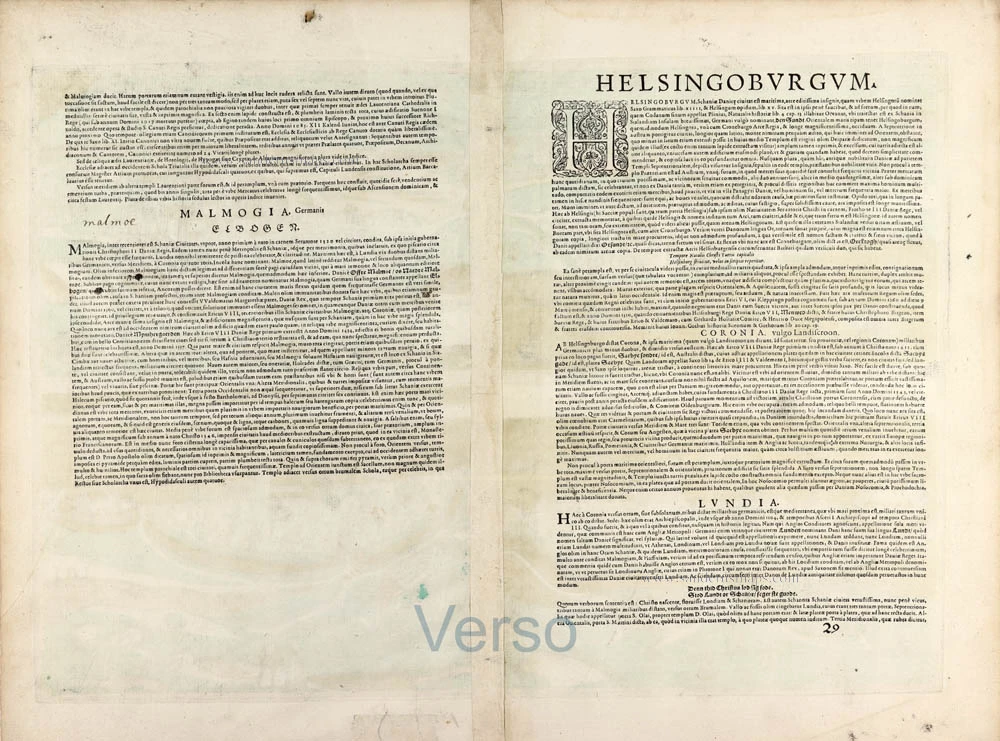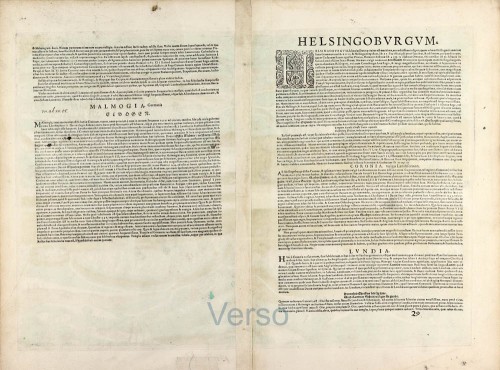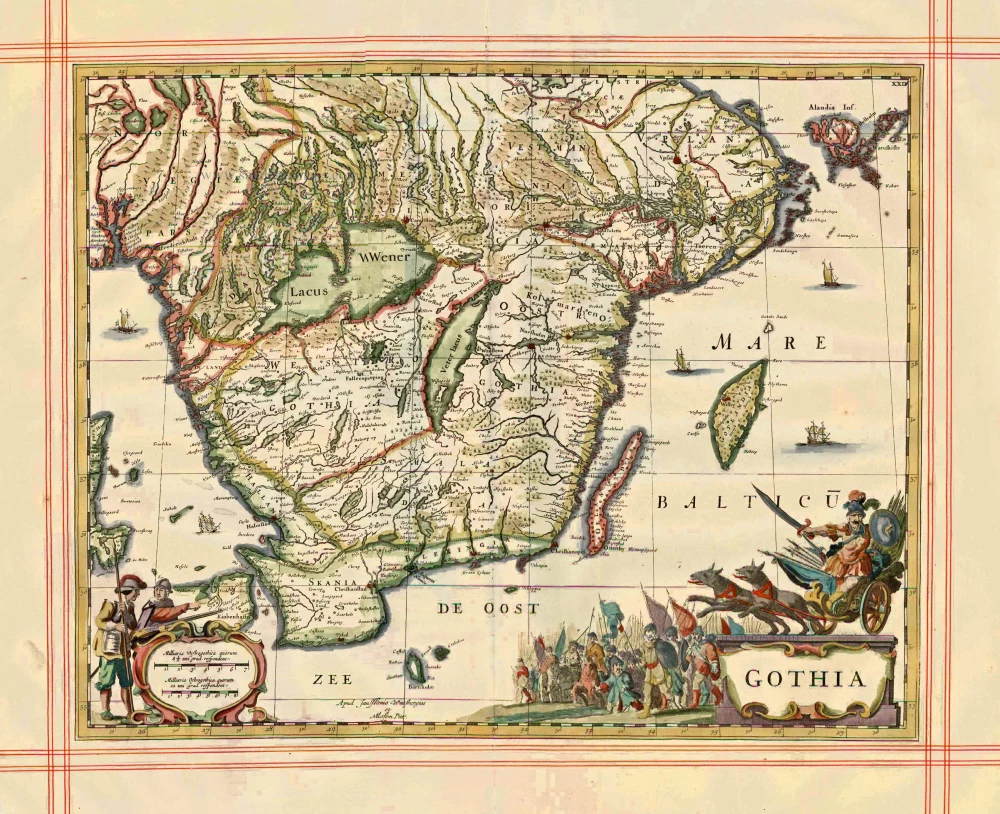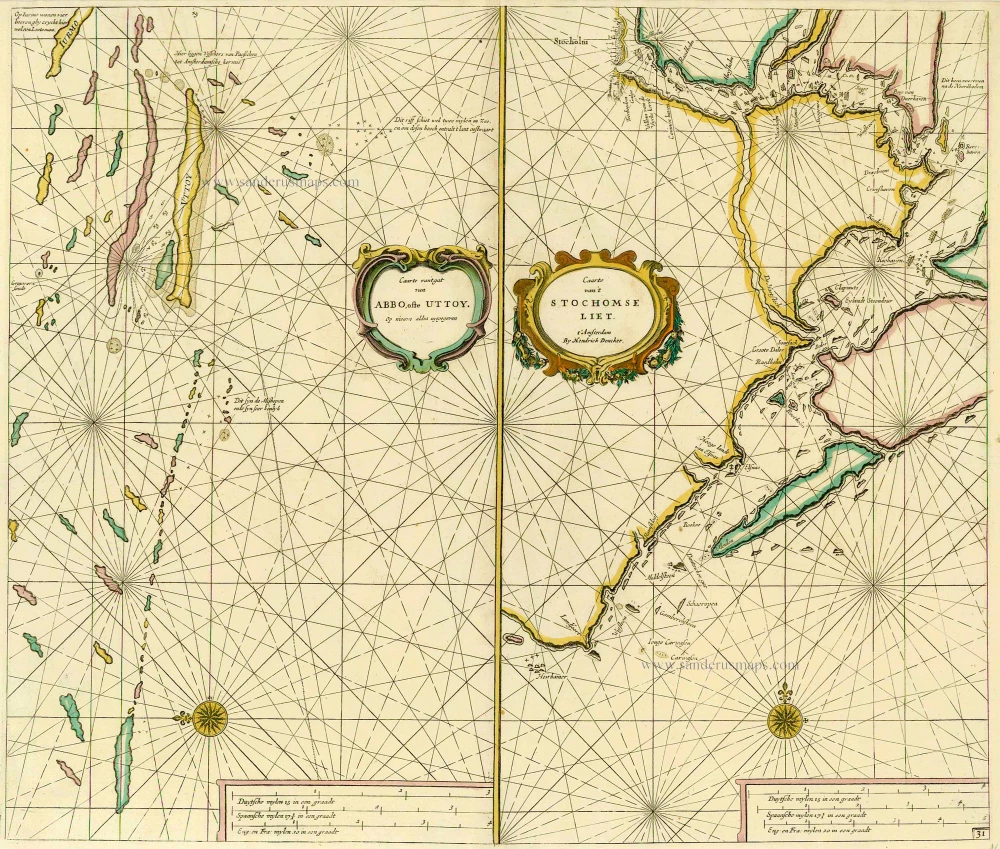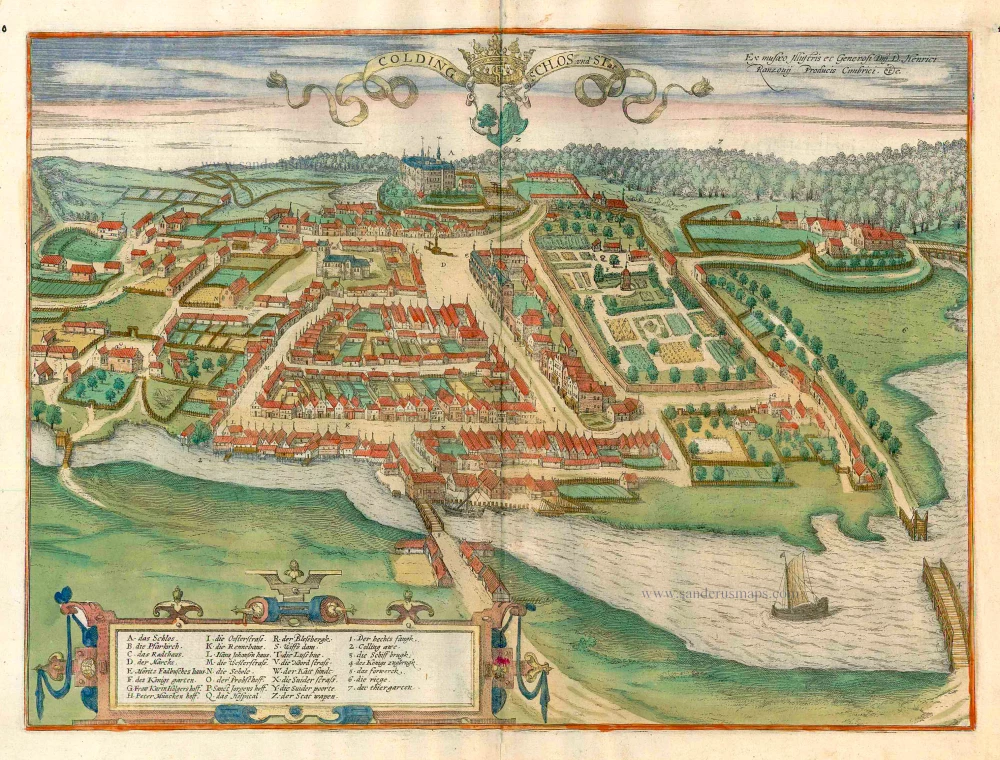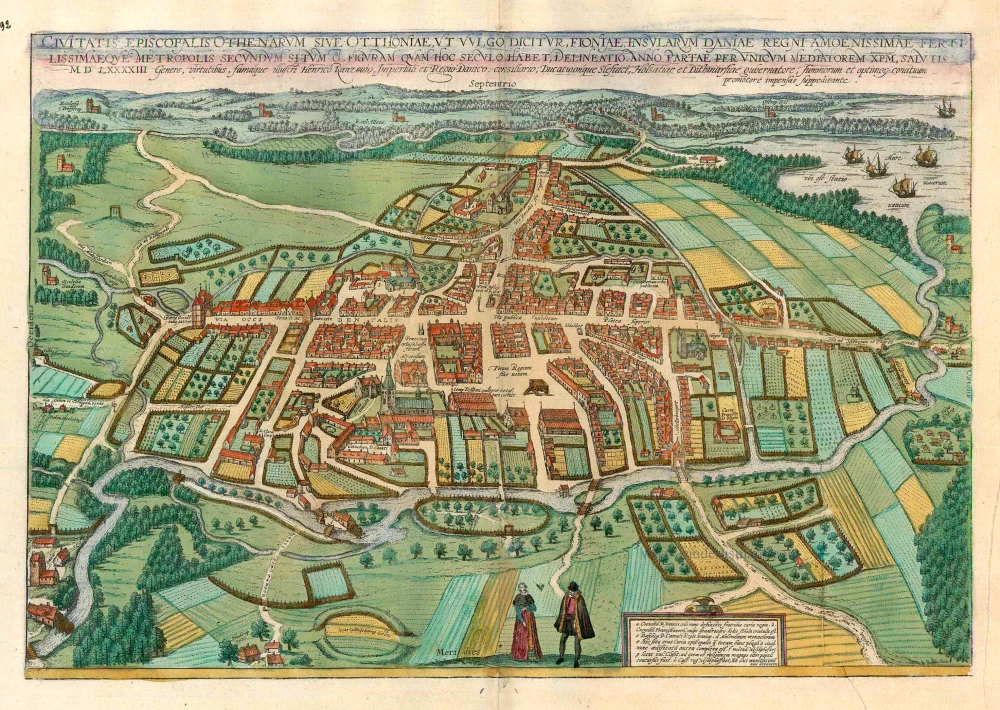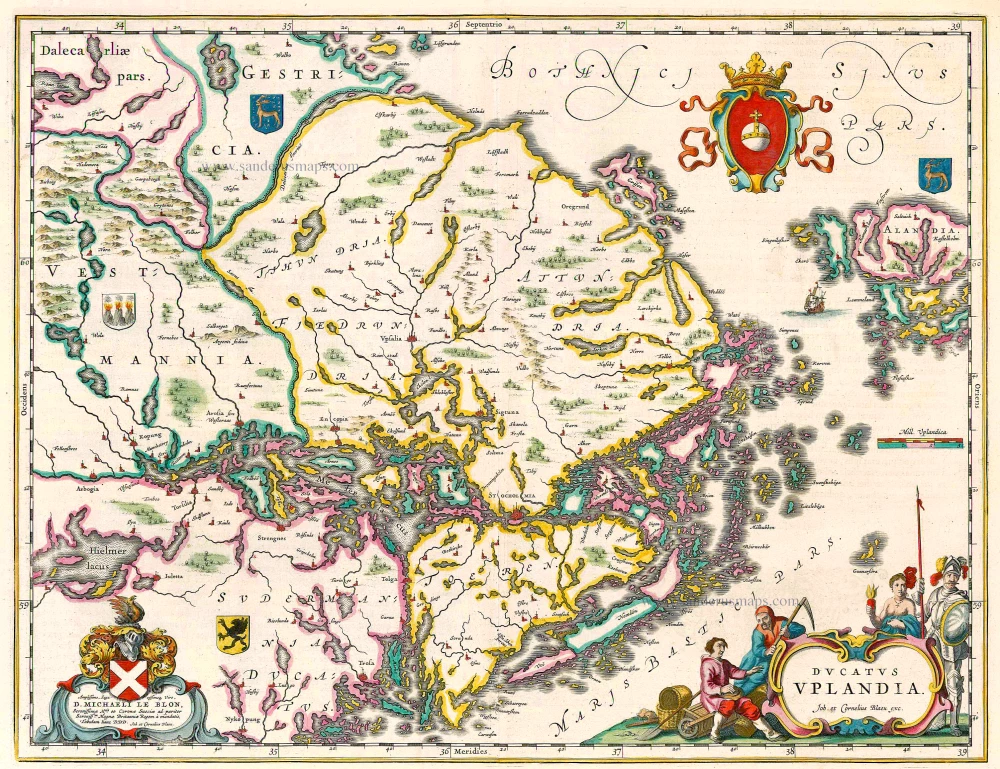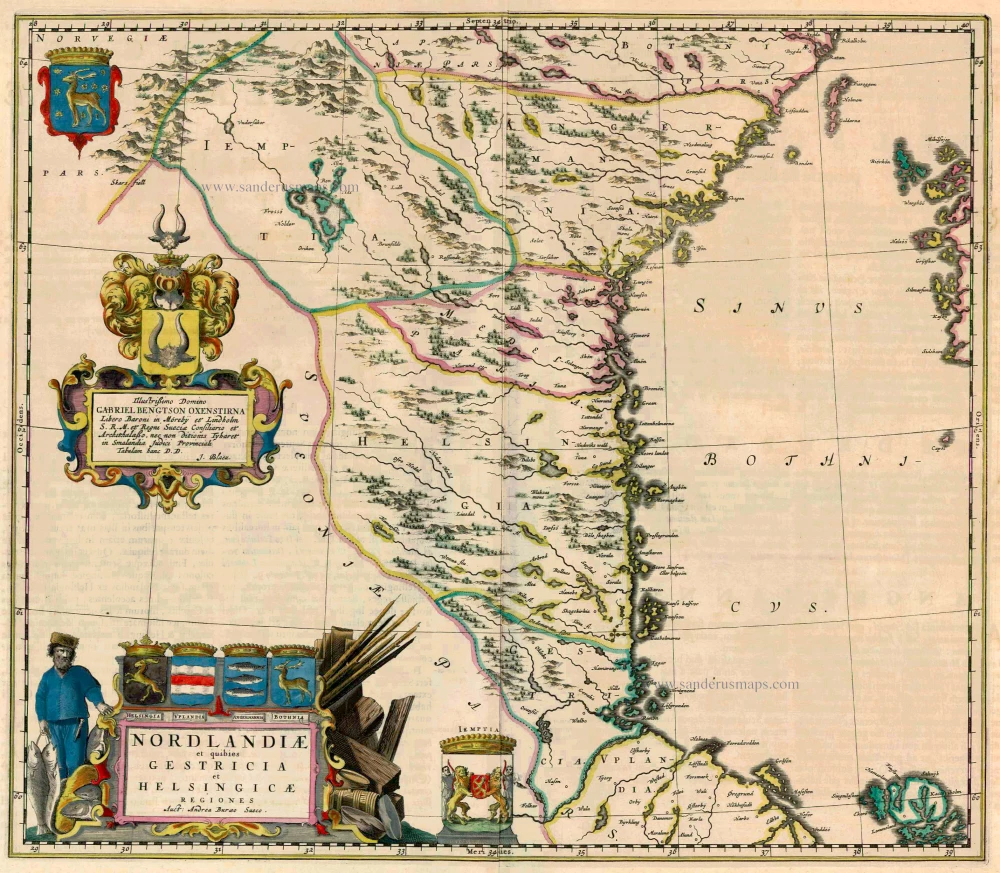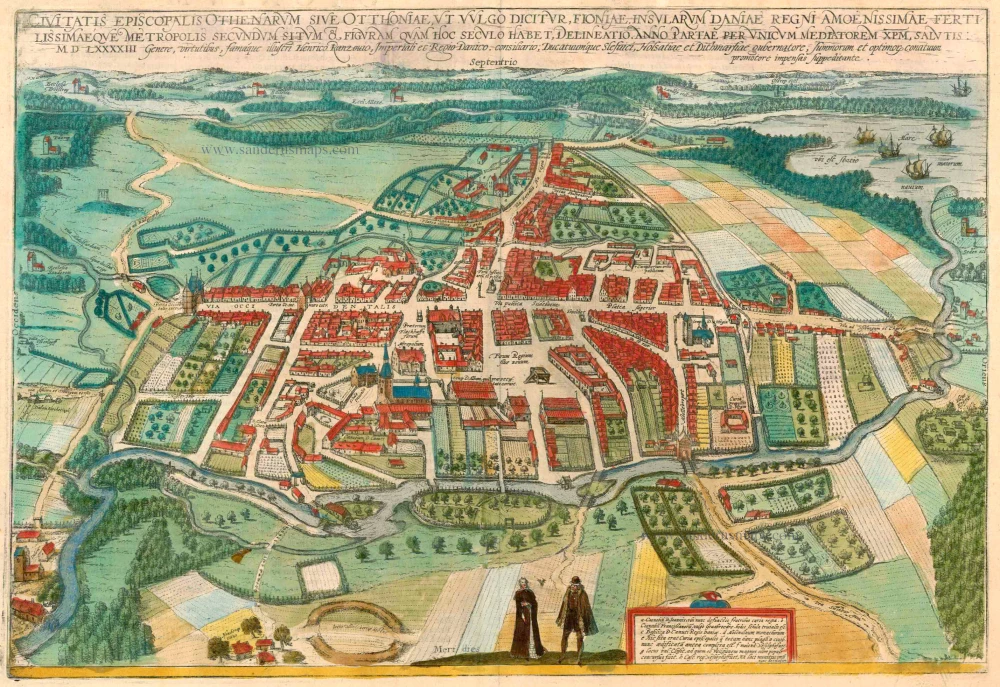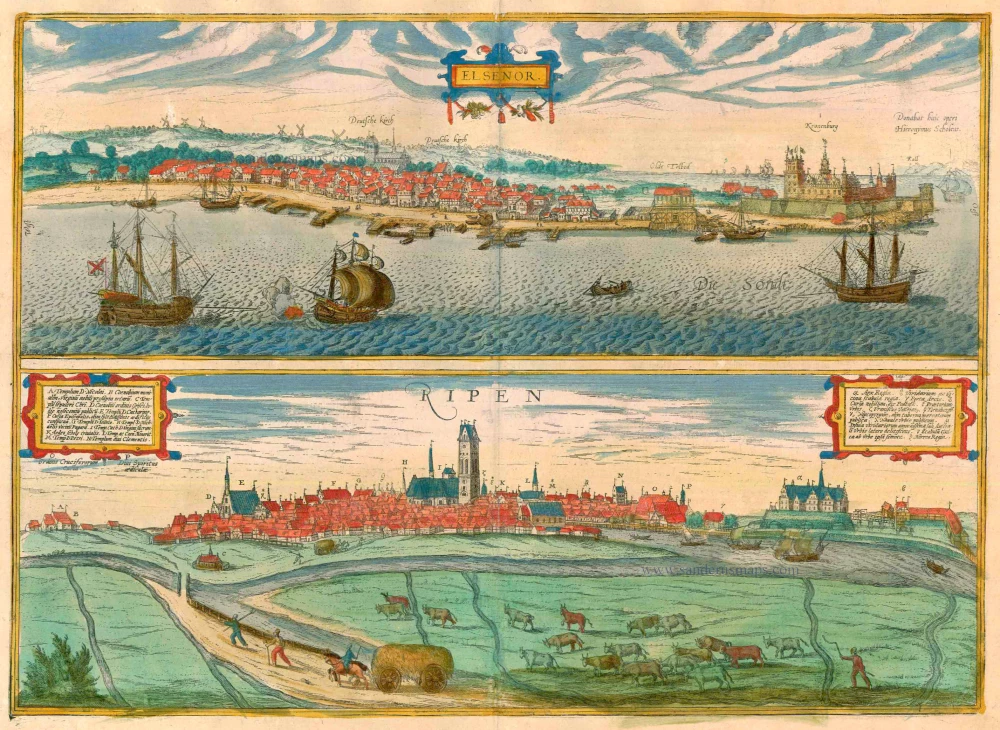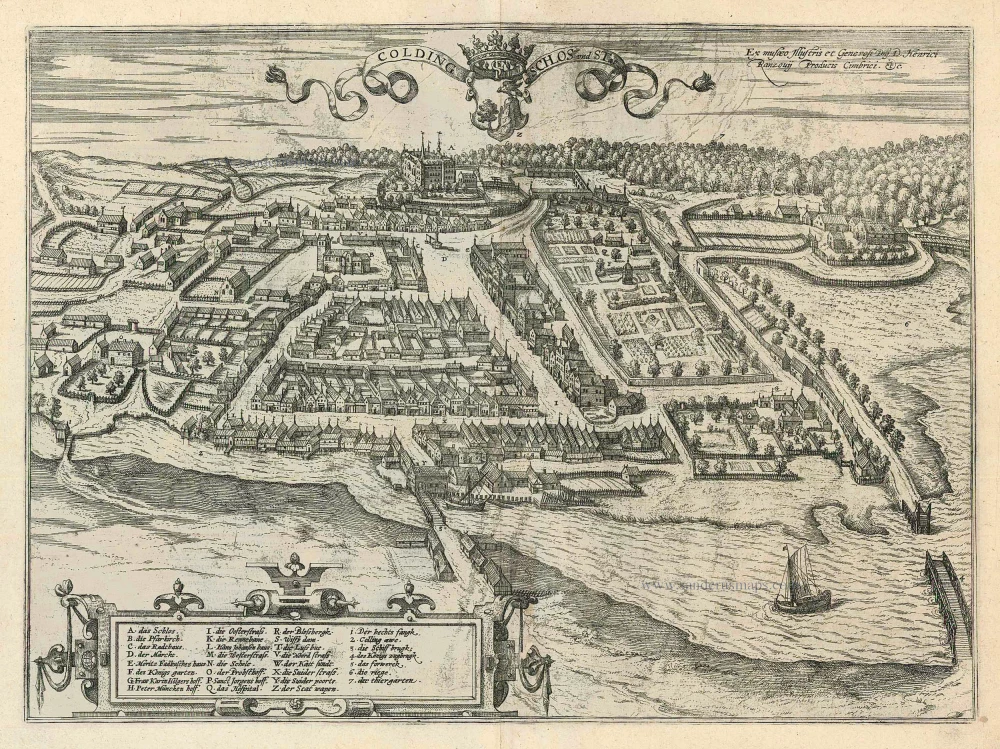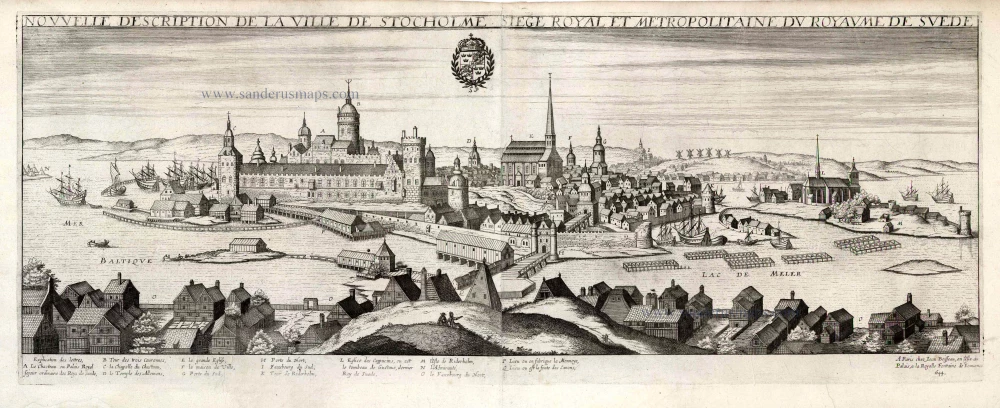First edition
Braun and Hogenberg : Malmö, Helsingborg, Lund, Landskrona. 1588
HELSINGBORG
COMMENTARY BY BRAUN (on verso): "Helsingborg, a coastal city in the province of Scania in Denmark, with a high castle, [...] lies on the eastern shore of the sea, just as Helsingor together with the royal and magnificent castle of Kronborg is situated on its west coast. [...] In the middle of Helsinborg is a church dedicated to Our Lady, which is not quite as splendid because it is built only of brick, but it is wonderfully big and high."
This view towards the northeast from a cavalier perspective shows the harbour town situated at the narrowest point of the Öresund, which developed under the protection of the fortress built in 1150. This castle was extended to the 14th century and became one of the strongest fortresses in northern Europe. On the site of an earlier Romanesque church, the church of St Mary was built in the 15th century as a three-nave Gothic "pseudo basilica" in the heart of the city, at the time one of the biggest churches in Denmark. The city's importance declined after the more modern castle of Kronborg was built on the other side of the sound in the 15th and 16th centuries. After a chequered history, Helsingborg now belongs to Sweden, which it has done since 1719.
LUND
COMMENTARY BY BRAUN (on verso): "Lunden was once the seat of an archbishopric [...]. But nothing can be found in the histories to tell us when and by whom it was built. Those who believe that the English founded it seem to have let themselves be deceived by the sound of the name, which this city shares with Lunden, the capital of England. For the Germans, call both cities Lunden. But the Danes call this city Lunde, which in Danish means forest or wood.".
This view towards the south from a cavalier perspective shows the small, unfortified town of Lund, dominated by the cathedral with its towers. At times, there were 27 churches and monasteries in and around Lund. But the town was also important as a centre for merchants and artisans. It developed from a Viking settlement and was made an episcopal see in 1060. With the Reformation and the loss of the archbishopric, the city rapidly declined, and the university's founding in 1666 did little to change this. Only in the 20th century did the Swedish city of Lund develop into one of the most important university towns in Scandinavia.
MALMÖ
COMMENTARY BY BRAUN (on verso): "Elbogen is one of Scania's youngest cities since it was built only around 1320 [...]. Nevertheless, it is now practically the capital of Scania due to the trade, which over the years has made it famous after fish were caught in great abundance, and the city of Lund began to lose its old reputation. The inhabitants call this city Malmö, but the Germans insist in calling it Elbogen, because of its shape, which is reminiscent of an elbow."
This view in cavalier perspective from the east shows the city fortified with an earthen rampart and moat. Malmö is first documented in 1275. Unlike the other cities on the sound, which were planned from the beginning, Malmö literally evolved into a trade centre. The beach served as a harbour for the flat-bottomed merchant ships in the busy strait. At the beginning of the 14th century construction began on the Gothic parish church of St Peter. Malmö became prosperous through trade and was granted a municipal charter in 1353. Erik of Pomerania built a castle in the east of the aspiring city in 1434.
LANDSKRONA
COMMENTARY BY BRAUN (on verso): "Landskrona is also a harbour town; it lies about one and a half German miles south of Helsingborg. Originally it was built by King Erik VIII of Denmark in 1413 at a place where there was already a village. It was called Säbysondre, that is, village in the south, which is why there is a street with this name in the town today, which the inhabitants call Säby Street."
This is a view towards the west of Landskrona, a town on the Öresund, which has the only natural harbour on the west coast of Scania. In 1410 a monastery was built there by the Carmelites, who were called into the country by the Nordic Union. By 1413 the town had grown to such an extent that it was granted a municipal charter. Landskrona needed strong fortifications, for from the end of the 14th century the Öresund was a highly contested strait. In 1549 Christian III built a citadel here, which can be seen on the right.
Braun G. & Hogenberg F. and the Civitates Orbis Terrarum.
The Civitates Orbis Terrarum, also known as the 'Braun & Hogenberg', is a six-volume town atlas and the most excellent book of town views and plans ever published: 363 engravings, sometimes beautifully coloured. It was one of the best-selling works in the last quarter of the 16th century. Georg Braun, a skilled writer, wrote the text accompanying the plans and views on the verso. Many plates were engraved after the original drawings of a professional artist, Joris Hoefnagel (1542-1600). The first volume was published in Latin in 1572 and the sixth in 1617. Frans Hogenberg, a talented engraver, created the tables for volumes I through IV, and Simon van den Neuwel made those for volumes V and VI. Other contributors were cartographers Daniel Freese and Heinrich Rantzau, who provided valuable geographical information. Works by Jacob van Deventer, Sebastian Münster, and Johannes Stumpf were also used as references. Translations appeared in German and French, making the atlas accessible to a broader audience.
Since its original publication of volume 1 in 1572, the Civitates Orbis Terrarum has left an indelible mark on the history of cartography. Seven more editions followed the first volume in 1575, 1577, 1582, 1588, 1593, 1599, and 1612. Vol.2, initially released in 1575, saw subsequent editions in 1597 and 1612. The subsequent volumes, each a treasure trove of historical insights, graced the world in 1581, 1588, 1593, 1599, and 1606. The German translation of the first volume, a testament to its widespread appeal, debuted in 1574, followed by the French edition in 1575.
Several printers were involved: Theodor Graminaeus, Heinrich von Aich, Gottfried von Kempen, Johannis Sinniger, Bertram Buchholtz, and Peter von Brachel, all of whom worked in Cologne.
Georg Braun (1541-1622)
Georg Braun, the author of the text accompanying the plans and views in the Civitates Orbis Terrarum, was born in Cologne in 1541. After his studies in Cologne, he entered the Jesuit Order as a novice, indicating his commitment to learning and intellectual pursuits. In 1561, he obtained his bachelor's degree; in 1562, he received his Magister Artium, further demonstrating his academic achievements. Although he left the Jesuit Order, he continued his studies in theology, gaining a licentiate in theology. His theological background likely influenced the content and tone of the text in the Civitates Orbis Terrarum, adding a unique perspective to the work.
Frans Hogenberg (1535-1590)
Frans Hogenberg was a Flemish and German painter, engraver, and mapmaker. He was born in Mechelen as the son of Nicolaas Hogenberg.
By the end of the 1560s, Frans Hogenberg was employed upon Abraham Ortelius's Theatrum Orbis Terrarum, published in 1570; he is named an engraver of numerous maps. In 1568, he was banned from Antwerp by the Duke of Alva and travelled to London, where he stayed a few years before emigrating to Cologne. He immediately embarked on his two most important works, the Civitates, published in 1572 and the Geschichtsblätter, which appeared in several series from 1569 until about 1587.
Thanks to large-scale projects like the Geschichtsblätter and the Civitates, Hogenberg's social circumstances improved with each passing year. He died as a wealthy man in Cologne in 1590.
Helsheborch [on sheet with] Lunden [and] Elbogen [and] Landeskron.
Item Number: 30136 Authenticity Guarantee
Category: Antique maps > Europe > Northern Europe
Four Swedish bird's-eye views by Braun and Hogenberg: Helsingborg, Lund, Malmö, Landskrona.
Title: Helsheborch [on the sheet with] Lunden [and] Elbogen [and] Landeskron.
Date of the first edition: 1588.
Date of this map: 1588.
Copper engraving, printed on paper.
Image size: 335 x 478mm (13.19 x 18.82 inches).
Sheet size: 395 x 535mm (15.55 x 21.06 inches).
Verso: Latin text.
Condition: Original coloured, excellent.
Condition Rating: A+.
From: Liber Quartus Urbium Praecipuarum Totius Mundi. Cologne, 1588. (Koeman, B&H4, Van der Krogt 4, 41:1.4)
HELSINGBORG
COMMENTARY BY BRAUN (on verso): "Helsingborg, a coastal city in the province of Scania in Denmark, with a high castle, [...] lies on the eastern shore of the sea, just as Helsingor together with the royal and magnificent castle of Kronborg is situated on its west coast. [...] In the middle of Helsinborg is a church dedicated to Our Lady, which is not quite as splendid because it is built only of brick, but it is wonderfully big and high."
This view towards the northeast from a cavalier perspective shows the harbour town situated at the narrowest point of the Öresund, which developed under the protection of the fortress built in 1150. This castle was extended to the 14th century and became one of the strongest fortresses in northern Europe. On the site of an earlier Romanesque church, the church of St Mary was built in the 15th century as a three-nave Gothic "pseudo basilica" in the heart of the city, at the time one of the biggest churches in Denmark. The city's importance declined after the more modern castle of Kronborg was built on the other side of the sound in the 15th and 16th centuries. After a chequered history, Helsingborg now belongs to Sweden, which it has done since 1719.
LUND
COMMENTARY BY BRAUN (on verso): "Lunden was once the seat of an archbishopric [...]. But nothing can be found in the histories to tell us when and by whom it was built. Those who believe that the English founded it seem to have let themselves be deceived by the sound of the name, which this city shares with Lunden, the capital of England. For the Germans, call both cities Lunden. But the Danes call this city Lunde, which in Danish means forest or wood.".
This view towards the south from a cavalier perspective shows the small, unfortified town of Lund, dominated by the cathedral with its towers. At times, there were 27 churches and monasteries in and around Lund. But the town was also important as a centre for merchants and artisans. It developed from a Viking settlement and was made an episcopal see in 1060. With the Reformation and the loss of the archbishopric, the city rapidly declined, and the university's founding in 1666 did little to change this. Only in the 20th century did the Swedish city of Lund develop into one of the most important university towns in Scandinavia.
MALMÖ
COMMENTARY BY BRAUN (on verso): "Elbogen is one of Scania's youngest cities since it was built only around 1320 [...]. Nevertheless, it is now practically the capital of Scania due to the trade, which over the years has made it famous after fish were caught in great abundance, and the city of Lund began to lose its old reputation. The inhabitants call this city Malmö, but the Germans insist in calling it Elbogen, because of its shape, which is reminiscent of an elbow."
This view in cavalier perspective from the east shows the city fortified with an earthen rampart and moat. Malmö is first documented in 1275. Unlike the other cities on the sound, which were planned from the beginning, Malmö literally evolved into a trade centre. The beach served as a harbour for the flat-bottomed merchant ships in the busy strait. At the beginning of the 14th century construction began on the Gothic parish church of St Peter. Malmö became prosperous through trade and was granted a municipal charter in 1353. Erik of Pomerania built a castle in the east of the aspiring city in 1434.
LANDSKRONA
COMMENTARY BY BRAUN (on verso): "Landskrona is also a harbour town; it lies about one and a half German miles south of Helsingborg. Originally it was built by King Erik VIII of Denmark in 1413 at a place where there was already a village. It was called Säbysondre, that is, village in the south, which is why there is a street with this name in the town today, which the inhabitants call Säby Street."
This is a view towards the west of Landskrona, a town on the Öresund, which has the only natural harbour on the west coast of Scania. In 1410 a monastery was built there by the Carmelites, who were called into the country by the Nordic Union. By 1413 the town had grown to such an extent that it was granted a municipal charter. Landskrona needed strong fortifications, for from the end of the 14th century the Öresund was a highly contested strait. In 1549 Christian III built a citadel here, which can be seen on the right.
Braun G. & Hogenberg F. and the Civitates Orbis Terrarum.
The Civitates Orbis Terrarum, also known as the 'Braun & Hogenberg', is a six-volume town atlas and the most excellent book of town views and plans ever published: 363 engravings, sometimes beautifully coloured. It was one of the best-selling works in the last quarter of the 16th century. Georg Braun, a skilled writer, wrote the text accompanying the plans and views on the verso. Many plates were engraved after the original drawings of a professional artist, Joris Hoefnagel (1542-1600). The first volume was published in Latin in 1572 and the sixth in 1617. Frans Hogenberg, a talented engraver, created the tables for volumes I through IV, and Simon van den Neuwel made those for volumes V and VI. Other contributors were cartographers Daniel Freese and Heinrich Rantzau, who provided valuable geographical information. Works by Jacob van Deventer, Sebastian Münster, and Johannes Stumpf were also used as references. Translations appeared in German and French, making the atlas accessible to a broader audience.
Since its original publication of volume 1 in 1572, the Civitates Orbis Terrarum has left an indelible mark on the history of cartography. Seven more editions followed the first volume in 1575, 1577, 1582, 1588, 1593, 1599, and 1612. Vol.2, initially released in 1575, saw subsequent editions in 1597 and 1612. The subsequent volumes, each a treasure trove of historical insights, graced the world in 1581, 1588, 1593, 1599, and 1606. The German translation of the first volume, a testament to its widespread appeal, debuted in 1574, followed by the French edition in 1575.
Several printers were involved: Theodor Graminaeus, Heinrich von Aich, Gottfried von Kempen, Johannis Sinniger, Bertram Buchholtz, and Peter von Brachel, all of whom worked in Cologne.
Georg Braun (1541-1622)
Georg Braun, the author of the text accompanying the plans and views in the Civitates Orbis Terrarum, was born in Cologne in 1541. After his studies in Cologne, he entered the Jesuit Order as a novice, indicating his commitment to learning and intellectual pursuits. In 1561, he obtained his bachelor's degree; in 1562, he received his Magister Artium, further demonstrating his academic achievements. Although he left the Jesuit Order, he continued his studies in theology, gaining a licentiate in theology. His theological background likely influenced the content and tone of the text in the Civitates Orbis Terrarum, adding a unique perspective to the work.
Frans Hogenberg (1535-1590)
Frans Hogenberg was a Flemish and German painter, engraver, and mapmaker. He was born in Mechelen as the son of Nicolaas Hogenberg.
By the end of the 1560s, Frans Hogenberg was employed upon Abraham Ortelius's Theatrum Orbis Terrarum, published in 1570; he is named an engraver of numerous maps. In 1568, he was banned from Antwerp by the Duke of Alva and travelled to London, where he stayed a few years before emigrating to Cologne. He immediately embarked on his two most important works, the Civitates, published in 1572 and the Geschichtsblätter, which appeared in several series from 1569 until about 1587.
Thanks to large-scale projects like the Geschichtsblätter and the Civitates, Hogenberg's social circumstances improved with each passing year. He died as a wealthy man in Cologne in 1590.

